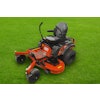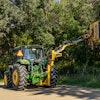HOW WE DID IT
- Recognized opportunity to fill void left by exiting dealership
- Hired talent from the exiting dealership
- Worked with OEM to start slow and proceed with caution
- Mapped-out vision for who target customer would be and how to reach that target customer
- Created financial plan that would allow for necessary investments to support new product line
Toward the end of 2008, the Fletcher family started to notice some warning signs of economic hardship. Rather than batten down the hatches and attempt to ride out the oncoming recession, they decided to take a bit of a risk in order to create another revenue stream and appeal to a new segment of potential customers.
“We approached New Holland,” says Frank Fletcher, the second-generation co-owner of Fletcher’s Sales & Service in Greensburg, PA. “The area New Holland dealership, which was literally two miles from us, had gone out of business in 2006. But in the late-90s they were a full-line New Holland dealer. For whatever reason, New Holland had pulled out of that dealership in 2004.” Within a couple of years, that dealership’s fate was sealed—creating a golden opportunity for Fletcher’s.
Partner with a Leader
In order to expand into ag-related markets, Fletcher says it was important to partner with a leader. John Deere and Kubota already had dealerships in the area. The availability of New Holland, which Fletcher says is the third big name in the industry, made this expansion a real possibility.
Fletcher’s Sales & Service had already hired two employees from the failed New Holland dealership. “We figured that this dealership must have had sold quite a bit of equipment over the years,” Fletcher says, “so there should be this market of people already out there. The next closest dealer was about 45 miles from us, so we’d have some room to grow. So I called New Holland.”
Flooring, Freight and Margins
Fletcher ended up talking on the phone with the person in charge of new dealer development at New Holland, who eventually came out to the dealership to present the New Holland program. Fletcher says there were a lot of differences as compared to the typical lawn and garden equipment program he’d grown accustomed to.
“Everything is put on their flooring,” Fletcher points out. “You’re not dealing with a distributor—you’re dealing direct with the manufacturer. Depending on the product line, or even horsepower for that matter, the product may be shipped in different manners; some models you can buy one at a time, others you have to buy an entire container. And aside from a special sales promotion, there’s freight tied to almost every single machine—unlike some of the programs our mower manufacturers offer where we can buy into a certain bracket and have our freight charge waved.” Fletcher says this is at least partially attributable to the fact that a lot of the equipment is manufactured overseas.
While the freight charges, relatively speaking, are minimal, they do add up—helping to further erode already tight margins. “The margins on this type of equipment really shocked me at first,” Fletcher relates, while adding that they can sometimes dip into the single digits. Still, 9% on a $20,000 tractor puts more money in the bank than 15% on a $10,000 zero-turn. So Fletcher has been, for the most part, pleased.
Pricing and Sales Efforts Something that hasn’t been quite as pleasing—although it’s getting better—is the challenge associated with selling this type of equipment. “Pricing-out all of the different options is a lot of work,” Fletcher says. “For instance, if you buy a 60-hp tractor, it comes standard with certain features. But then you can add an entirely separate book of features.”
Thus far, Fletcher has been spearheading the majority of the New Holland sales effort, mainly because it would be rather difficult to create a price list and train another employee(s) on how to use it. “We sell Exmark mowers, and it only took a couple of hours to create a standardized price list for the entire line,” Fletcher says. “It’s easy to tell your salespeople that this is what we are all going to sell this model for, and this is what we are going to sell that model for. But how can you do that for a product with as many variables as a tractor? It’s a one-on-one situation with each customer.”
Thankfully, Fletcher says, New Holland is now getting more standardized with certain models. Selling the line in general is getting easier, simply because the Fletchers have a couple of years under their belts.
“We were lucky in that New Holland allowed us to start with just tractors for the first 10 months,” Fletcher recalls. Then, after fielding several inquiries from prospective customers, the dealership expanded into hay tools, which qualifies it to begin carrying other ag-related tools such as manure spreaders, rakes, balers and sickle-bar mowers.
Fletcher’s Sales & Service has been selling New Holland equipment to small area farms, rural customers with 4 or 5 acres, and gentleman farmers. “The gentleman farmer is the ideal customer,” Fletcher says. “He’s a doctor or other professional with 10 acres and a couple of horses. He wants to buy the total package.”
Supporting the New Line
While skid-steer loaders and mini-excavators are not presently part of the plan, they could be in the future. If the Fletchers go that route, however, building and staff changes will have to coincide.
Some of that has already taken place just to support the tractors and hay equipment the dealership is already selling. The Fletcher’s invested roughly $35,000 in a 10,000-pound forklift from The Forklift Center; the 5,000-pounder they already owned wasn’t big enough. And because the dealership didn’t have a loading dock, the Fletcher’s had to invest another $15,000 in a portable dock that chains to the trailer. “We made sure it was aluminum because we’re storing it outside,” Fletcher adds.
Fletcher’s Sales & Service already owned a 26,000-gross-vehicle-weight rollback truck that had come in real handy for lawn tractor and zero-turn mower deliveries. But it’s barely cutting the mustard when it comes to the bigger New Holland units. Despite the required investments and challenges associated with diversifying into a very different, in some ways more complex product line, the Fletchers are very pleased with what they’ve been able to accomplish thus far—and what the future holds in terms of further expansion and growth opportunity.




![T708 2025 Ga Tl11 R3 Hr [1 Q5 A1066]](https://img.greenindustrypros.com/mindful/acbm/workspaces/default/uploads/2025/10/t708-2025-ga-tl11r3-hr-1q5a1066.KcuUhTiF78.jpg?auto=format%2Ccompress&fit=crop&h=100&q=70&w=100)






![T708 2025 Ga Tl11 R3 Hr [1 Q5 A1066]](https://img.greenindustrypros.com/mindful/acbm/workspaces/default/uploads/2025/10/t708-2025-ga-tl11r3-hr-1q5a1066.KcuUhTiF78.jpg?ar=16%3A9&auto=format%2Ccompress&fit=crop&h=135&q=70&w=240)







